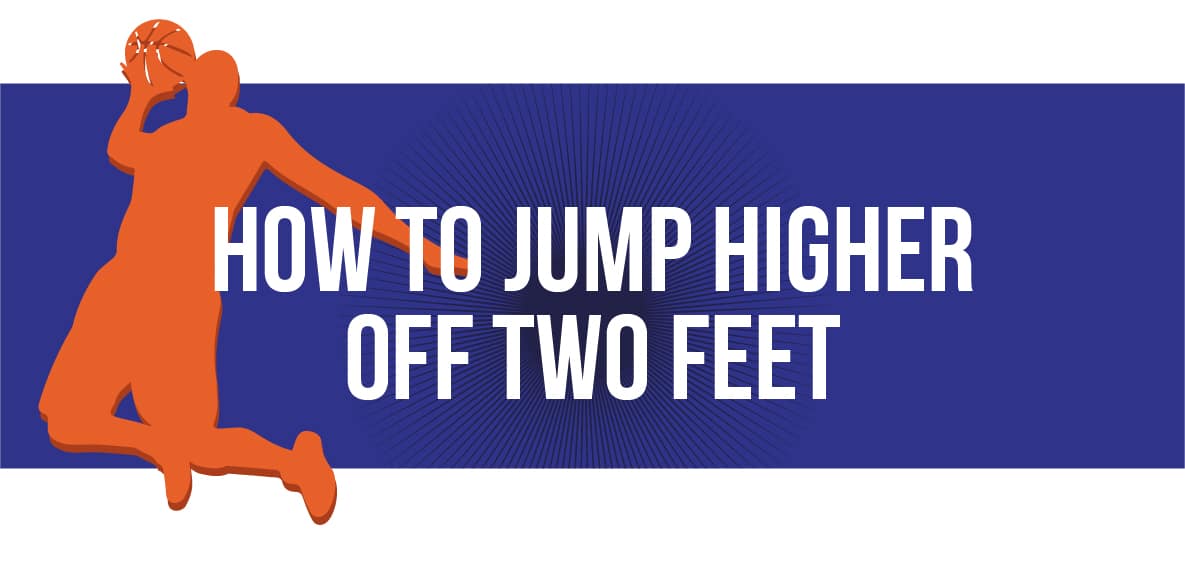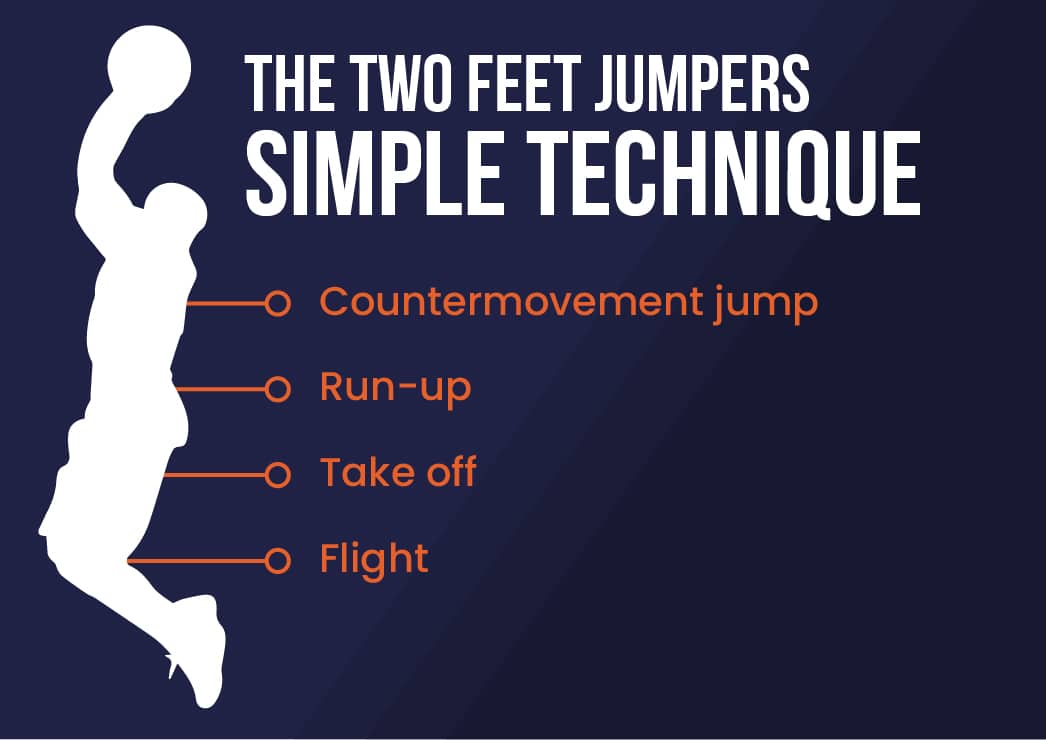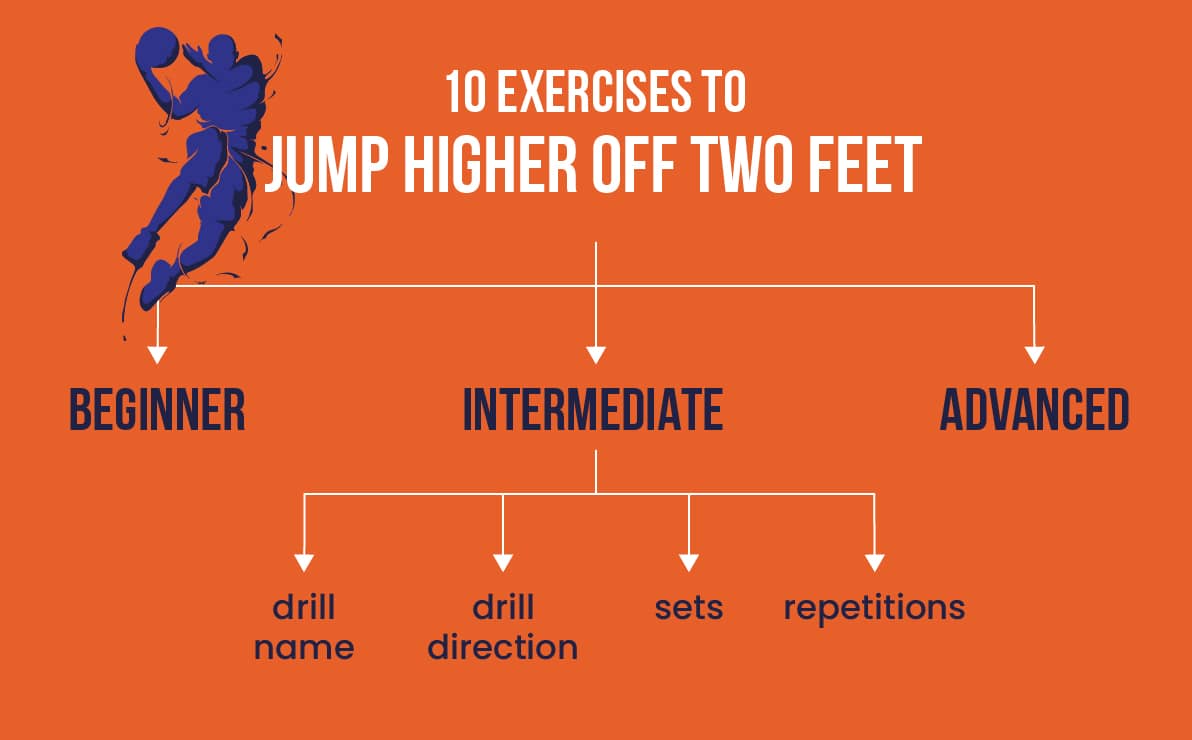
Training to jump higher off two feet has less to do with the generation of the explosive power which is needed for jumping, and more to do with developing strength and range of motion in critical joints and ligaments used during the jump motion.
You obviously cannot just ignore training that helps you produce, store and subsequently release explosive energy. However, the generation of that power will mean very little if you do not know how to manage it properly and efficiently when jumping off two feet.
When training to jump higher off one foot, for example, the emphasis is invariably on increasing strength in all of the muscles that are associated with the jump motion. Jumping higher off one foot is all about raw power, while jumping higher off two feet has more to do with technique, momentum and coordination.
The exercises in this blog will help you do that better.
Do You Jump Higher Off Two Feet Or One Foot?
There are several sporting codes that lend themselves to jumping off two feet, instead of one, especially codes where the athlete is expected to execute a Vertical Jump from an almost “stationary position”.
If you compete in any one of those sports you need to figure out How To Jump Higher off two feet, because you need all the explosive power you can produce during the take off.
There is also compelling and sometimes overwhelming evidence to suggest that better overall flight heights are recorded when you opt to jump off two feet, instead of the one.
It is also true that there is an increased take-off height recorded when jumping off one foot. However, that does not mean the overall jump off one foot will be higher once the jump motion has been completed. Sometimes talent and sheer will can defy the science though.
The Mechanic Of Two Feet Jumping Technique

1- Approach or Countermovement
It is perfectly reasonable to expect an athlete to jump off two feet either following a run-up or from what we have chosen to call a “stationary position”.
When you prepare to jump from a stationary position, there needs to be tremendous emphasis on the countermovement. The science definitely tells us that you will achieve far greater heights from a countermovement jump and not a squat jump.
When we explore Workouts To Jump Higher later in this blog, there will be exercises that focus on the muscle groups that will matter most when trying to generate this explosive power from a stationary position - countermovement or not.
2- Run-up
The one sport that is probably most associated with jumping is basketball and in basketball, you are seldom in a stationary position. The point here is that you are often going to be exposed to conditions that demand a run-up before jumping and you will then need to have meaningful clarity on whether you are going to do this off two feet or one.
For those who plan to jump off two feet, following a run-up, the greatest difficulty is going to be establishing rhythm, without breaking it.
3- Take-off
The loss of momentum and even rhythm is inevitable when preparing to take off from two feet. You can try to compensate for that by generating significant speed during the run-up.
Your run-up is going to have to be a lot faster than that of those who take off from one foot. In addition, the final step or lunge, before the take-off matters a considerable amount when taking off from two feet.
The larger or wider final step, allows you to try and establish some meaningful countermovement, which remains critical despite the existence of a run-up.
4- Flight
There is a transitional phase that needs to be taken into account when jumping off two feet - and a considerable amount of that actually has to do with the take-off.
Remember that up to the point where you plant your two feet, for jumping, you would have generated horizontal speed. There needs to be a conversion from that horizontal speed, to vertical speed - which is exceedingly difficult to pull off when you are doing this with two feet.
We would suggest that the foot plant firstly needs to be slightly in front of your body, which should really be the case in all jumping circumstances. However, there needs to be a little more emphasis on that here.
One of the two feet will also need to be slightly in front of the other during this transitional phase.
Depending on which foot your plant, you will then need to slant your body in the direction from whence you came. So, you are almost rocking backwards before rocking forward again at the take-off. Think about the slingshot again!
How well you fly hinges heavily on how smooth that transition is. Once in flight, the strength and agility of your body’s core will come into play. When we talk about the strength of the core, we are also talking about the strength of the back muscles and not just the abs.
Because of the limitations that you will now have with your arms - which have already done so much work during the transition - you are going to need both of your legs and your core to work extra time during flight.
The Best 12 Powerful Exercises To Jump Higher Off Two Feet

Beginner Workout
1-
Drill Name: Toe Jumps
Drill Goal:
A Plyometrics drill to increase the capacity of your calf muscles
Also to increase your capacity to take off from the front half of your feet and not from your heels
Drill Direction:
So, we have already hinted that the focus of this drill should be on jumping off the balls of your feet. That is all it really is.
Once your feet are together, lift up your heels and then start jumping for as long as you can without allowing your heels to touch the ground.
2-
Drill Name: Heel Jumps
Drill Goal:
To isolate the hamstrings, quads and buttocks
To practise jumping without the help of those three muscle sets. In essence, you are just jumping off your heels here
Drill Direction:
For the duration of this drill, you should stand with your two feet apart, probably wider than shoulder lengths apart.
Then you should bend backwards into a squatting position. You could start off by balancing your back against the wall or you could balance off your fingers behind you.
Once your squat is balanced, you should then begin jumping but be careful not to lean forward onto your toes here.
3-
Drill Name: Split Jump Squat
Drill Goal:
To increase the capacity of all the major muscle jumping groups. That includes quads, calves, hamstrings, buttocks, back and the body’s core.
Drill Direction:
Start the drill by placing your right foot in front of you and your left foot behind you - then squat.
Because of the position you are in, you will likely find that most of your weight will be on your toes.
From that position you will then jump up into the air, as high as you can and then alternate the position of your two legs when landing. Keep alternating until you feel you can go no more.
4-
Drill Name: Frog Jumps
Drill Goal:
Increase your capacity to jump off the balls of your feet.
Drill Direction:
You start this drill by positioning yourself like a frog, or a baseball catcher - whichever sounds more palatable. So, that is feet apart, at about shoulder width - and then in a squatting position.
Then, like a frog you will take off into the air and try to land as efficiently as possible in that same position again, before taking on the next leap.
Intermediate Workout
5-
Drill Name: Pistol Squat
Drill Goal:
To help increase the strength, mobility and balance in your leg muscles.
Drill Direction:
You should probably actually start this drill in a standing position with your arms stretched out - which places the much needed emphasis on the balance in this routine. Your hands should be at shoulder level throughout the drill.
After that, you can then show us how low you can go on just one leg, while your free leg will be stretched out in front of you. Once you have gone as low as you can, you face the enormous task of lifting your body up again.
6-
Drill Name: Leg Curl
Drill Goal:
There are few better isolation drills for the hamstrings.
Drill Direction:
Lie down on the leg curl machine, tummy facing down and back up. Slip your calves under the weight resistance and lift those weights up by flexing your lower legs against the weight resistance.
The closer you get to the buttocks, the better. Completing between 10 and 15 reps per session should be just the tonic.
7-
Drill Name: Standing Calf Raise
Drill Goal:
This is a worthy isolation exercise for the calves.
Drill Direction:
The routine can be carried out with either one or two feet. The ball is in your court. Maybe start with two feet and then move onto the one foot.
When you are on the elevated surface, your task will then be to raise your heel as much as possible before lowering it again.
Balance matters just as much as strength here and don’t demand more from your body that it can handle.
For some people, just using the body weight will cut the mustard. However, if you feel the need to challenge yourself, the weight resistance will come into the equation. Again, you know better than anybody just how much your body can handle.
8-
Drill Name: Broad Jump
Drill Goal:
As a primary function, you perform this exercise to provide a workout for the quads. As a secondary function, you workout the calves, flexors and hamstrings.
Drill Direction:
Perform a full countermovement, by also fully exploiting the use of the arm swing and the hip flex backwards, before exploding up and forwards. Like you would with the long-jump in track and field, just without the run-up or the sandpit.
Advanced Workout
9-
Drill Name: Seated Calf Raise
Drill Goal:
Strengthens the lower leg muscles, in a way that few exercises actually can
Drill Direction:
Sit down on the machine and slide your lower legs under the weights. They should be stationed just above your knees. You will then push down on the balls of your feet again, to lift the weight higher.
Don’t push off your heels! That is pretty important.
10-
Drill Name: Crunches
Drill Goal:
To strengthen your abdominal core and maybe develop a six-pack while you are at it.
Drill Direction:
Lie down on the floor, with your face up, as if you were preparing for the more traditional sit-up routine. Then bend your knees and then flex your elbows, to help lift your head.
Instead of going all the way up, as you would with a sit-up, you then curl your shoulders in the direction of the pelvic region. Don’t lift your lower back up though. That needs to remain touching the floor for the duration of this routine.
That helps take the hips out of the equation and places all of the emphasis on the abs.
11-
Drill Name: Seated Leg Raise
Drill Goal:
Seeks to increase abdominal strength
Drill Direction:
Once seated on the surface, raise your legs out in front of you...at full stretch. Then pull your knees towards your chest and release again.
Don’t do these too fast because having control throughout the routine matters and don’t do more than your body would ordinarily require for the routine to be a success.
12-
Drill Name: Depth Jumps
Drill Goal:
You perform this exercise to increase the strength in your hips, lower back and the legs.
Drill Direction:
Step up onto an elevated surface and then step down from that surface, before exploding up into the air. The less time you spend on the ground surface, the better and you should always try to explode as high as possible into the air.
Conclusion
Jumping Higher Off One Foot is difficult enough already, even for the most seasoned of athletes out there. However, Jumping Higher Off Two Feet can be a serious complication. It is a lot for your head to wrap around and worrying less about overall body strength gives you one less thing to think about.
Exercises To Jump Higher help alleviate some of the psychological stress associated with trying to Jump Higher Off Two Feet.
The routines we have listed above will help you get there - and if done well they will help you get there a lot quicker than had initially been envisaged.
Hey, I’m Aleksandar and I am a Basketball freak! That is why I decided to create this blog. Teaching people How to dunk a basketball and How to Jump Higher in this sport or other related sports that require vertical jumping, is my specialty. If that’s your aim, then you have come to the right place.
